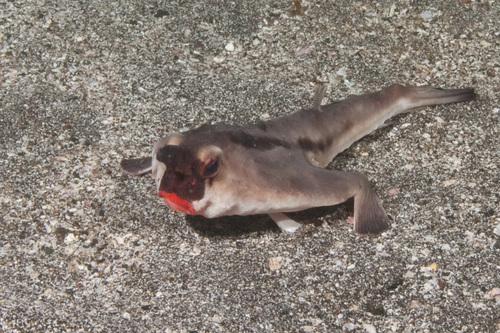
Red-lipped Batfish
The Atlantic bluefin tuna (Thunnus thynnus) is a majestic and powerful fish, renowned for its size, speed, and incredible migrations. This highly sought-after species plays a critical role in the marine ecosystem and is of significant commercial importance.
8 12 years
Lifespan
20 - 25 cm
Length
Least Concern
Conservation Status
0 km/h
Swimming speed
Carnivorous, Scavengers
Diet
Sedentary
Migration
Appearance Overview
The Atlantic bluefin tuna is renowned for its large, streamlined body, built for speed and endurance in the open ocean.
Color
Dark metallic blue on top, with a silvery-white underside
Body Shape
Torpedo-shaped, with a crescent-shaped tail
Fins
Two dorsal fins, the first retractable; small, yellow finlets running down the back and belly
Length
Up to 10 feet (3 meters), commonly 6.5 feet (2 meters)
Weight
Up to 1,500 lbs (680 kg), commonly 550 lbs (250 kg)
Diet
Carnivorous, feeding on a variety of fish (such as herring, mackerel, and hake), squid, and crustaceans.
Feeding Behavior
Highly active predator that uses its speed and agility to hunt. They often hunt cooperatively, herding and trapping prey.
Social Behavior
Forms large schools, especially during migration and spawning. Schools can be mixed with other tuna species. Exhibit complex migratory patterns, often crossing entire oceans.
Commercial Relevance
Extremely high value, particularly in the sushi and sashimi market. Individual fish can be sold for tens or even hundreds of thousands of dollars. Also important for recreational fishing.
Conservation measures
Subject to strict fishing quotas and regulations set by international bodies like ICCAT. Efforts include monitoring populations, enforcing catch limits, and protecting spawning grounds.
Status
Endangered (IUCN)
Threats
Historically heavily overfished, leading to significant population declines. Other threats include bycatch in fishing gear targeting other species, and climate change affecting prey distribution.
Habitat Distribution
Depth Range
Primarily found in the epipelagic zone (0-200 meters), but can dive to depths of over 900 meters (3,000 feet).
Geographic Range
Western and eastern Atlantic Ocean, including the Mediterranean Sea. Major spawning grounds are in the Gulf of Mexico and the Mediterranean Sea.
Preferred Environment
Prefers temperate and subtropical waters. They are highly migratory, following warm water currents and prey.
Reproduction and Life Cycle
Breeding Habits
Spawns in warm waters, primarily in the Gulf of Mexico and the Mediterranean Sea during spring and summer. Spawning is highly synchronized.
Development Stages
Eggs hatch into larvae, which are initially planktonic. They grow rapidly, undergoing metamorphosis into juveniles and eventually adults.
Fecundity
Highly fecund; a single female can release up to 30 million eggs per spawning season.
Maturity Age
Reaches sexual maturity relatively late, typically between 4-8 years, though this can vary.
Faqs about Red-lipped Batfish
How long do Atlantic bluefin tuna live?
Atlantic bluefin tuna can live for up to 40 years, although this is becoming increasingly rare due to fishing pressure.
How fast can Atlantic bluefin tuna swim?
They are among the fastest fish in the ocean, capable of bursts of speed up to 43 mph (70 km/h).
Can I eat Atlantic bluefin tuna?
Yes, but it's crucial to ensure it comes from a sustainable source. Look for certifications or recommendations from reputable organizations.
Where are Atlantic bluefin tuna found?
They are found in the Atlantic Ocean, from the Gulf of Mexico to the Mediterranean Sea, and from Newfoundland to Brazil.
Are Atlantic bluefin tuna warm-blooded?
Atlantic bluefin tuna are warm-blooded, unlike most fish, which allows them to maintain a higher body temperature than the surrounding water.
Which organization regulates bluefin tuna fishing?
ICCAT (International Commission for the Conservation of Atlantic Tunas) is the main regulatory body.
How do bluefin tuna reproduce?
Females release millions of eggs into the water, which are then fertilized externally by males.
Why are bluefin tuna so valuable?
Their large size and high fat content make them ideal for sushi and sashimi.
Why are bluefin tuna endangered?
Bluefin tuna populations have declined significantly due to overfishing.
Copyright @ Nature Style Limited. All Rights Reserved.
 English
English